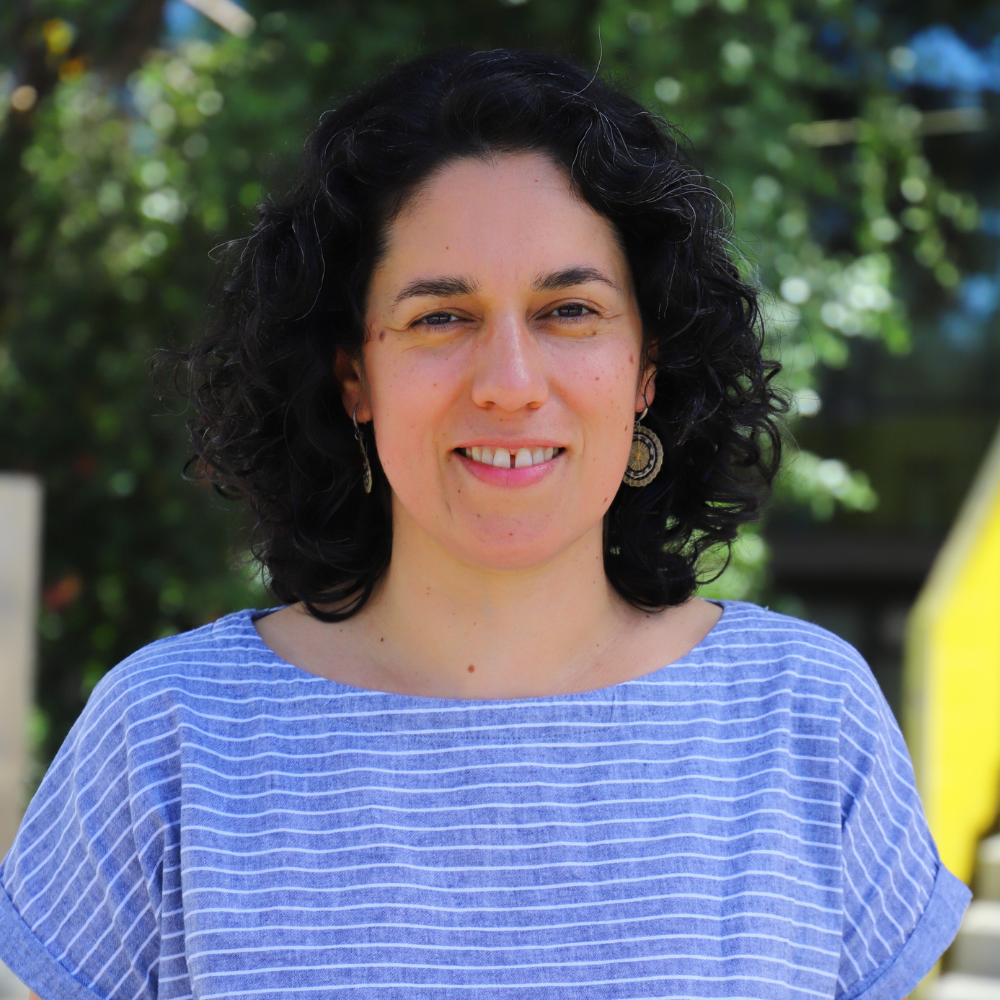15
Tania Villaseñor Jorquera ● Profesora Asistente

Doctor en Cs. Geológicas, Universidad de Florida (EE.UU)
Geóloga, Universidad de Chile
Descripción
Tania es geóloga, con especialización en el área de sedimentología y estratigrafía de sedimentos marinos y continentales. Se interesa en reconstruir la transferencia de sedimento a través del paisaje continental y marino a diferentes escalas de tiempo y espacio a partir del análisis de proveniencia del sedimento (arena, limo, arcilla) y la geomorfología de las cuencas. Sus investigaciones buscan identificar las regiones que aportan sedimento a las cuencas (erosión), los periodos de mobilización del sedimento y la influencia de cambios climáticos así como las actividades antropogénicas en estos procesos. Sus proyectos incluyen la reconstrucción de dinámicas de erosión glaciar y transporte de sedimento durante el Pleistoceno-Holoceno y el estudio de flujos de sedimento fluvial en Chile central en el Antropoceno.
En el Instituto de Ciencias de la Ingeniería, Tania desarrolla investigación en el área de Geociencias.
13
- REVISTA Quaternary Science Reviews
- 2024
Multisequal aeolian deposition during the Holocene in southwestern Patagonia (51°S) was modulated by southern westerly wind intensity and vegetation type
• Valentina Flores-Aqueveque • Tania Villaseñor Jorquera •
- REVISTA Journal of South American Earth Sciences
- 2024
Holocene sedimentary processes in the Turbio river valley (Chile, 30°S): Paleoclimatic implications for the semi-arid Andes
• Marion San Juan Diaz • Tania Villaseñor Jorquera • Valentina Flores-Aqueveque •
- REVISTA Geochemistry, Geophysics, Geosystems
- 2017
The impact of rapid sediment accumulation on pore pressure development and dehydration reactions during shallow subduction in the Gulf of Alaska
• Lanie Meridth • Elizabeth Screaton • John Jaeger • Stephanie James • Tania Villaseñor Jorquera
- REVISTA Proceedings of the IODP
- 2017
Data Report: permeability, grain size, biogenic silica, and clay minerals of Expedition 341 sediments from sites U1417 and U1418
• Elizabeth Screaton • Tania Villaseñor Jorquera • Stephanie James • Lanie Meridth • John Jaeger
- REVISTA Sedimentology
- 2015
Evaluation of the relative roles of global versus local sedimentary controls on Middle to Late Pleistocene formation of continental margin strata, Canterbury Basin, New Zealand
• Tania Villaseñor Jorquera • John Jaeger • Kathleen Marsaglia • Greg Browne •
- REVISTA Proceedings of the IODP
- 2013
Data report: quantitative powder X-ray diffraction analysis from the Canterbury Basin, Expedition 317
• Tania Villaseñor Jorquera • John Jaeger •
- REVISTA Journal of South American Earth Sciences
The Pangal landslide complex, Cachapoal basin, central Chile (34°S): An example of a multi-temporal slope instability cluster in the Andes
• Sergio A Sepúlveda • Stella Moreiras • Diego Chacon • Tania Villaseñor Jorquera • Pilar Jeannerete
- REVISTA Journal of South American Earth Sciences
Spatial and temporal changes in suspended sediment fluxes in central Chile induced by the mega drought: The case of the Itata River Basin (36°-37°S)
• Vicente Mendez-Freire • Tania Villaseñor Jorquera • Claudia Mellado •
- REVISTA Earth-Science Reviews
Comparability of heavy mineral data The first interlaboratory round robin test
• István Dunkl • Hilmar von Eynatten • SergioAndò • KenoLünsdorf • Andrew Morton
- REVISTA Sedimentary Geology
Provenance of northwestern Patagonian river sediments (4448°S): A critical evaluation of mineralogical, geochemical and isotopic tracers
• Dawei Liu • Sebastien Bertrand • Tania Villaseñor Jorquera • Toon Van Dijck • Nathalie Fagel
- REVISTA Advances in Geosciences
The influence of early experiences and university environment for female students choosing geoscience programs: a case study at Universidad de Chile
• Tania Villaseñor Jorquera • Sergio Celis • Juan Pablo Queupil • Luisa Pinto • Maisa Rojas
- REVISTA Basin Research
The changing Patagonian landscape: Erosion and westward sediment transfer paths in northern Patagonia during the Middle and Late Pleistocene
• Tania Villaseñor Jorquera • Daniel Tentori • Kathleen Marsaglia • Luisa Pinto •
- REVISTA GSA Special Papers Tectonics, Sedimentary Basins, and Provenance: A Celebration of the Career of William R. Dickinson
Use of sedimentary petrology and provenance to resolve questions regarding the Neogene depositional setting of the southwestern rim of the Amazon Basin (Rio Madre de Dios retroforeland region, Peru and Bolivia)
• Jasmyn Nolasco • Kathleen Marsaglia • Kenneth Campbell • Fritz Hertel • Tania Villaseñor Jorquera
- REVISTA Geochemistry, Geophysics, Geosystems
The impact of rapid sediment accumulation on pore pressure development and dehydration reactions during shallow subduction in the Gulf of Alaska
• Lanie Meridth • Elizabeth Screaton • John Jaeger • Stephanie James • Tania Villaseñor Jorquera
- REVISTA Proceedings of the IODP
Data Report: permeability, grain size, biogenic silica, and clay minerals of Expedition 341 sediments from sites U1417 and U1418
• Elizabeth Screaton • Tania Villaseñor Jorquera • Stephanie James • Lanie Meridth • John Jaeger
- REVISTA Earth and Planetary Science Letters
Linking Late Pleistocene alpine glacial erosion and continental margin sedimentation: Insights from 40Ar/39Ar dating of silt-sized sediment, Canterbury Basin, New Zealand
• Tania Villaseñor Jorquera • John Jaeger • David Foster •
- REVISTA Sedimentology
Evaluation of the relative roles of global versus local sedimentary controls on Middle to Late Pleistocene formation of continental margin strata, Canterbury Basin, New Zealand
• Tania Villaseñor Jorquera • John Jaeger • Kathleen Marsaglia • Greg Browne •
- REVISTA Proceedings of the IODP
Data report: quantitative powder X-ray diffraction analysis from the Canterbury Basin, Expedition 317
• Tania Villaseñor Jorquera • John Jaeger •
- REVISTA Revista chilena de historia natural
Sedimentos laminados de la Bahía Mejillones como registro de cambios temporales en la productividad fitoplanctónica de los últimos ~ 200 años
• Magaly Caniupán • Tania Villaseñor Jorquera • Silvio Pantoja • Carina Lange • Gabriel Easton Vargas
- Enero 2023
- Marzo 2022
- Enero 2022
- Enero 2022
- - Enero 2024
- Marzo 2021
Co-Investigador/a
- Octubre 2019
- Marzo 2019
- Octubre 2018
Co-Investigador/a
- Octubre 2018
- - Octubre 2020
Co-Investigador/a
- Agosto 2018
- Marzo 2017
Co-Investigador/aCo-Investigador/a
- Septiembre 2012
- Mayo 2011
- Agosto 2008
- Marzo 2007
Co-Investigador/a